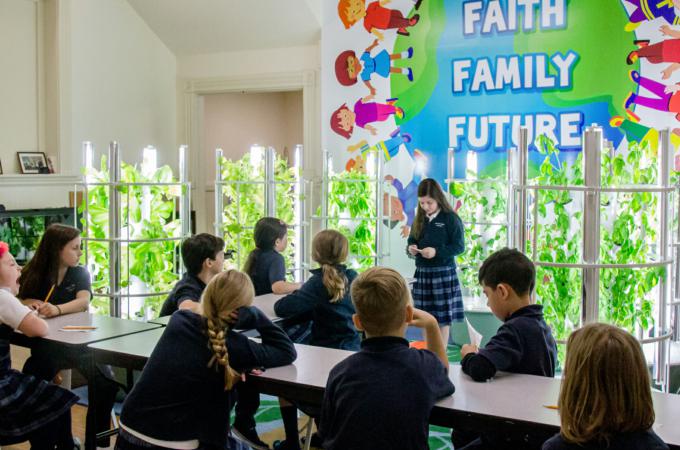Forming the Future: A rich harvest at St. John's School, North End
NORTH END -- Karen Shea's classroom in St. John School in the North End is furnished with tables, stools, and seven vertical garden towers each containing 20 plants. Ceiling fans simulate wind. The towers' lights and pumps are set on timers. The warmth from the lights and the sound of flowing water create a calm, soothing environment, a welcome reprieve for Shea's students when the weather turns cold.
Shea is the creator of GrowingUp, an urban farming initiative at St. John School. Two days each week, Shea uses the aeroponic garden to teach students about mindfulness, nutrition, food production, and community service as well as traditional academic subjects.
Shea's three sons attended St. John School, where she taught yoga and mindfulness classes for 12 years. She kept a tower garden at home and thought to introduce healthy eating at the school.
She asked the Grafton Group, a restaurant chain where her brothers work, to donate the school's first tower, which it received in the 2013-2014 school year. Shea used it to teach healthy eating to a small after-school group, starting with about four students, and it caught the attention of other students and teachers. The school eventually bought six more towers and put them in a central location where everyone could see them and "share the experience," Shea told The Pilot.
In the 2017-2018 school year, the school partnered with the Franciscan Food Center at St. Anthony Shrine to donate the produce from the garden to the hungry.
The school year is divided into three sessions of 10-12 weeks during which a few grades, ranging from pre-school to grade eight, attend Shea's classes. The plants grown in the towers -- including lettuce varieties, bok choy, kale, basil, and chard -- grow so quickly that a crop can be donated every week, so each grade goes through the harvesting process multiple times during their session. On Wednesdays, students harvest the produce, measure and record its weight, put it in bags, and deliver it to the Franciscan Food Center.
"They're all a part of it. It's really their process," Shea said when The Pilot visited the school Oct. 16.
Shea designed a multifaceted curriculum for GrowingUp, touching on all the subjects of STREAM -- Science, Technology, Religion, Engineering, Art, and Math. The youngest students use the roots and stems of the plants to paint pictures or make jewelry. Those learning how to write trace the letters to spell the names of the plants. Older students test the pH of the water. Groups use the Engineering Design Process to identify problems in the classroom and devise solutions, such as an organization system for seeds and fences to keep the towers' wires out of the way.
Shea plans age-appropriate versions of the same lessons for different grades.
"There's always a piece of the same work through each grade. It just gets progressively more involved," Shea explained.
To teach her students to be careful with the food, Shea tells them that if they would not eat it, they should not pack it. With this in mind, they handle the food gently during the packing process and carefully tear off parts that burn from growing into the lights.
"They do it from a careful place, a mindful place, and that's kind of what this becomes, a mindful meditation," Shea said.
Students also decorate cards, tags, or other pieces of art and attach them to the bags of food.
"When those people pick up that bag of food, they're not just picking up the bag of food, they're feeling the energy that you have put into the creation of it," Shea said.
She recounted how one student in the second grade remarked to her, "It's not just a bag of food, it's a bag of love."
"They get it. They understand that, really, that's the message, that they're helping people in need," Shea said.
GrowingUp is in its second year, which means Shea and her students can now compare their recorded data from one year to the next. Last year, St. John's School donated 194.5 pounds of food. This year, they hope to surpass 200.



















